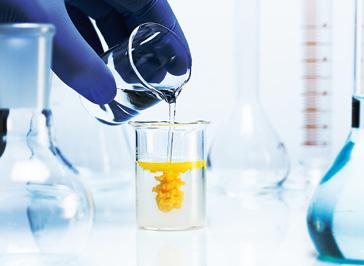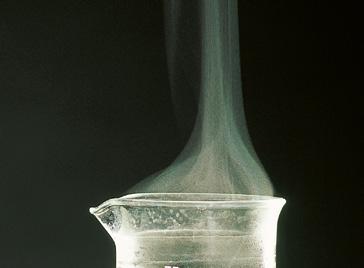
4 minute read
1. Chemical changes
CHEMICAL CHANGES
ä 1.1 Basic concepts
In a chemical reaction, we begin with substances called reactants, which are there before the chemical change. Then, new substances appear called products, which are a result of the chemical change.
The reactants must be in contact for a chemical change to occur. Physical changes occur during the process too, which make the change visible. You can see some examples below.
Energy exchange. Colour change. State change.
The drawing on the left shows the oxidation of nitrogen monoxide to form nitrogen dioxide. We can see that the atoms are in a different order, and that mass is conserved throughout the process.
Physical evidence of a chemical change


Working with pictures
From the information in the illustration, work out which bonds have broken and which have formed in the chemical change.
2 NO
O2
ä 1.2 Atomic theory of chemical reactions
The appearance of new substances in a chemical reaction is based on a reordering of the reactant atoms. For this to occur, the elemental units of the reactants must collide. These collisions break bonds and form new bonds, making new substances. Since this is a reordering of atoms, the total mass of the substances before and after the chemical reaction does not change, so we can state that:
During a chemical change, mass is conserved, which means that the total mass of the reactants must equal the total mass of the products. This statement is known as the law of conservation of mass.
Atomic theory and conservation of mass
2 NO2
ä 1.3 Writing a chemical reaction: the chemical
equation
We use chemical equations to describe chemical reaction quantitatively.
Chemical equations use stoichiometric coefficients to express the relationship between the reactants and products in a chemical reaction and the proportions of their elemental units.
Sometimes, they also give information about other factors, such as the state of matter of substances, their temperature or their pressure. Balancing a chemical equation involves choosing the values of the coefficients, in order to make sure that the number of atoms of each element is the same among the reactants as among the products.
Writing and balancing chemical equations
We will use the example of the reaction between ammonia and molecular oxygen. The products of this reaction are molecular nitrogen and water.
1 We write the formulas of the reactants and products, separating them with an arrow showing the direction of the reaction: NH3 + O2 8 N2 + H2O
2 We choose values for the stoichiometric coefficients to make the number of atoms of each element the same among the reactants and among the products. To do so: 2.1 First, we adjust the coefficients of the non-elemental substances: 2 NH3 + O2 8 N2 + 3 H2O 2.2 Then, we do the same for the elemental substances. If necessary, we correct the coefficients we chose before. We can use fractions. 2 NH3 + 3/2 O2 8 N2 + 3 H2O
We can also multiply by two the chemical equation so that there are no fractional coefficients: 2 NH3 + 3/2 O2 8 N2 + 3 H2O
4 3 2 6
3 Finally we check, element by element, that the number of atoms among the reactants is the same as among the products:
Note that the stoichiometric coefficient of molecular nitrogen is 1, therefore it is not written.
Elements Reactants Products
H atoms
N atoms
O atoms 4 NH3 (4 · 3 = 12)
4 NH3 (4 · 1 = 4)
3 O2 (3 · 2 = 6) 6 H2O (6 · 2 = 12)
2 N2 (2 · 2 = 4)
6 H2O (6 · 1 = 6) Focus on English
You probably already know the word equation from maths, as well as from chemistry. Have you ever wondered where it comes from? Equation comes from the Latin word aequatio, which means, an equal distribution. It can be used figuratively: ‘If we take Peter out of the equation, we will find a solution to the situation’. In can also be used in a scientific context, meaning the act of making equal or balanced: ‘To him, the equation was simple: time equals money’. With a classmate, discuss whether you agree with the following phrase by Albert Einstein: ‘One must divide one’s time between politics and equations. But our equations are much more important to me, because politics is for the present, while our equations are for eternity’.
Understand, think, search…
1 1-2-4. Draw a table, like the one in the example, for the following reaction:
CH4 + 2 O2 8 CO2 + 2 H2O
Which bonds are broken and which new bonds form? How many bonds are broken and how many new bonds form? 2 Explain what the stoichiometric coefficients mean in the exercise above. 3 Let’s check. Balance the following chemical reactions a) CO2 + H2O 8 H2CO3 b) NO + O2 8 NO2 c) Cr2O3 + Al 8 Al2O3 + Cr d) NO2 + H2O 8 HNO3 + NO e) C2H2 + O2 8 CO2 + H2O








